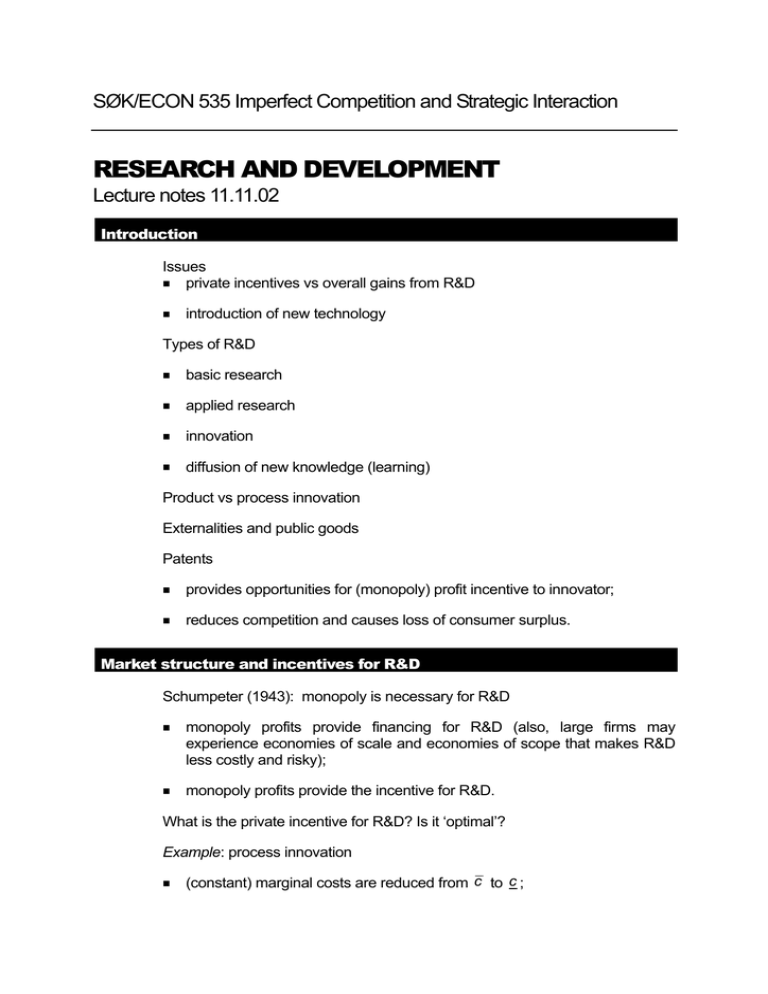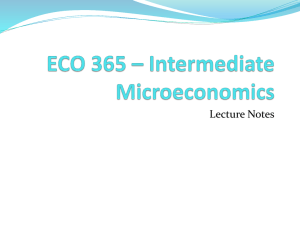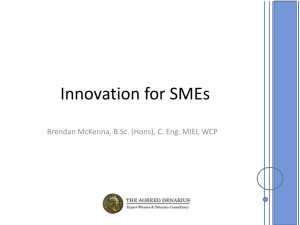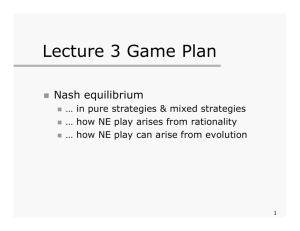RESEARCH AND DEVELOPMENT SØK/ECON 535 Imperfect Competition and Strategic Interaction
advertisement

SØK/ECON 535 Imperfect Competition and Strategic Interaction RESEARCH AND DEVELOPMENT Lecture notes 11.11.02 Introduction Issues private incentives vs overall gains from R&D introduction of new technology Types of R&D basic research applied research innovation diffusion of new knowledge (learning) Product vs process innovation Externalities and public goods Patents provides opportunities for (monopoly) profit incentive to innovator; reduces competition and causes loss of consumer surplus. Market structure and incentives for R&D Schumpeter (1943): monopoly is necessary for R&D monopoly profits provide financing for R&D (also, large firms may experience economies of scale and economies of scope that makes R&D less costly and risky); monopoly profits provide the incentive for R&D. What is the private incentive for R&D? Is it ‘optimal’? Example: process innovation (constant) marginal costs are reduced from c to c ; demand function is D ( p ) . Welfare gain Increase in consumer surplus per period (given that price equals marginal costs): c V = ∫ D ( c )dc s c Figure: area under the demand curve. Monopolist We have d Π m ∂Π m dp m ∂Π m ∂Π m = + = = −D p m ( c ) . dc ∂p dc ∂c ∂c ( ) The monopolist’s gain is consequently c V m =Π m ( c ) − Π ( c ) = ∫ D ( pm ( c ) ) dc m c m s m Since p ( c ) > c , it follows that V < V . Figure: area under demand curve between monopoly prices. Perfect competition Assume that initially all firms have costs c and hence the market price equals this level (Bertrand competition). Then some firm has costs reduced to c . We distinguish between m a drastic innovation: p ( c ) ≤ c ; and m a non-drastic innovation: p ( c ) > c . In the case of a non-drastic innovation, the incentive to innovate is 2 V c = [c − c ] D ( c ) . It follows that V m ( ) < V c < V s because D p m ( c ) < D ( c ) < D ( c ) , c ∈ [ c, c ] . Figure: area between costs for given demand. In the case of a drastic innovation, the incentive to innovate becomes pm ( c ) V =Π c m ( c ) = p ( c ) − c D ( p ( c ) ) = ∫ m m ( ) D p m ( c ) dc c Again, we find V m <Vc <Vs . Figure: monopoly profits at lowest possible cost. Conclusion The lack of opportunities for price discrimination implies that the incentive to innovate becomes too small. A monopolist has less to gain from a firm that is initially exposed to strong competition because the latter has a smaller profit initially (the replacement effect). Entry Assume there is one established incumbent and one potential entrant. The entrant enters only if he or she gets access to the new technology. m If only the monopolist can innovate, his or her incentive is V . c If only the entrant can innovate, his or her incentive is V (assuming there is Bertrand competition). Assume now that the two firms compete for the innovation (eg. by bidding on patent rights): d the entrant would be willing to pay at most Π ( c, c ) ; while m d the incumbent would be willing to pay at most Π ( c ) − Π ( c , c ) . 3 m d d Assuming that Π ( c ) ≥ Π ( c, c ) + Π ( c , c ) ( i.e., a perfect cartel results in higher industry profits than duopoly), it follows that the incumbent’s incentive to innovate is greater than that of the entrant. Intuition: because innovation and entry leads to greater competition the incumbent has more to lose (efficiency effect). cf. ‘sleeping patents (Gilbert and Newbery, 1982). Patent race Competition to be the first to innovate and obtain a patent. Extend the above model to a dynamic model: the probability, h, for a given firm to innovate at a given time t depends on the firm’s own R&D effort only; the probability of innovating over a period [t , t + dt ] when the firm invests xdt is h ( x ) dt , where h is increasing and concave and h′ ( 0 ) = ∞ ; the firm that innovates obtains an infinite patent (and no new innovations take place). The incumbent’s (Firm 1’s) incentive to innovate is given by m Πm (c ) Πd (c , c ) Π − + + c x h x h x ( ) 1 ( 1) ( 2) dt r r 0 Π m ( c ) − x1 + h ( x1 ) Π m ( c ) r + h ( x2 ) Π d ( c , c ) r ∞ V1 ( x1, x2 ) = ∫ e − rt e = where e − h ( x1 ) + h ( x2 ) t − h ( x1 ) + h ( x2 ) t r + h ( x1 ) + h ( x2 ) is the probability that no-one has innovated before time t. The entrant’s (Firm 2’s) incentive to innovate is given by Π d ( c, c ) − x2 dt V2 ( x1, x2 ) = ∫ e e h ( x2 ) r 0 h ( x 2 ) Π d ( c, c ) r − x 2 = r + h ( x1 ) + h ( x2 ) ∞ − rt − h ( x1 ) + h ( x2 ) t The relative strengths of Nash equilibrium R&D efforts is determined by two opposing effects 4 the efficiency effect, and the replacement effect. Two extreme cases: d m d drastic innovation: Π ( c, c ) = Π ( c ) and Π ( c , c ) = 0 , so there is no efficiency effect and hence the incumbent invests less than the entrant, i.e. x1 < x2 ; the probability of innovation is very high even for low levels of R&D effort ( lim x →∞ h ( x ) = ∞ ), which implies that firms will invest much in any case and hence the probability of an early innovation is high: then there is no replacement effect and hence the incumbent invests more x1 > x2 . Optimal R&D effort Duplication of effort may lead to over-investment. Learning The probability of innovation may depend on accumulated efforts. It is then typical that there will be strong competition and large investment when firms are level, while lagging firms quickly falls off. Spillovers Knowledge spillovers reduce the payoff from being first; and reduce the loss from not being first. Consequently, spillovers reduce incentives for innovation. Diffusion Consider a Bertrand duopoly and a non-drastic process innovation. Investment in the new technology C ′ < 0,C ′′ > 0, and C ( 0 ) 'large' . costs C (t ) at time t, with Due to the assumption of Betrand competition, at most one firm will invest in the new technology. 5 c c Competition to be the first to innovate leads to innovation at time t , where t is defined by ( ) C tc = 1 [c − c ] D ( c ) , r c that is, t is the first point in time that the investment is profitable the monopoly rent is completely dissipated (cf ‘rent-seeking’); no overall gain from the innovation (because the ex ante and ex post prices are the same). m − rt A monopolist would choose t so as to maximise V − C ( t ) e . 6







